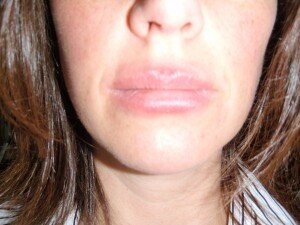Am I Allergic to Beeswax?
If you have a rash around your mouth, or your lips are constantly irritated, you may be allergic to beeswax. Well, actually, it is an allergic reaction to the propolis, or “bee glue”, that gets mixed with the wax. It has taken me over a year to solve the mystery of the exasperating recurring rash around my mouth and now that I have figured it out, I am sharing my findings so you can recognize the symptoms and heal your skin if you also suffer from an allergic lip rash that you previously have been unable to diagnose.
Beeswax is Great!
First let me extol the virtues of beeswax. Beeswax, also known by its INCI name as cera alba, is a natural wax produced by honey bees of the genus Apis. I love beeswax. I use it in so many of the skin care products I make because it is easy to work with and is so beneficial for the skin. It acts as a barrier to hold moisture in the skin but it is breathable and doesn’t block pores. It doesn’t go rancid so it needs no preservatives.
What is Propolis?
Beeswax is made by female worker honey bees and is used to build the walls of their honeycomb cells in which they store honey and pollen and raise their young. This wax is smooth, light yellow, and has the subtle (delicious!) aroma of honey. Propolis is a sticky resinous substance that bees collect from the sap of certain trees, mainly poplar and conifer. They blend the resinous substance with wax flakes secreted from glands on the underside of their abdomen and use this “glue” to line the cells of their honeycomb and to fill in gaps in the beeswax walls. Pure beeswax has not generally been shown to cause allergic reactions in people. But sometimes propolis remains mixed with the beeswax when it is harvested. It is the propolis (or rather, certain constituents in the propolis) that can cause contact dermatitis in people who become sensitized to it.
Propolis is a complex substance with many constituents. A few of those components have been isolated in studies and identified as the main allergens causing contact dermatitis (The main allergens found in propolis are 3-methyl-2-butenyl caffeate and phenylethyl caffeate, both of which are constituents of LB-1. LB-1 was the first allergen identified in propolis. For excellent details about the composition of propolis and resultant allergic reactions, read this Medscape article). The first recorded case of allergic contact dermatitis from propolis occurred in 1915 in a beekeeper with a rash on his hands and wrists. Since then, the allergic rash has been found not only on beekeepers but also on musicians and musical instrument makers (propolis is a common ingredient in some varnishes). There has been an increase in the frequency of allergic contact dermatitis in recent years due to the increased use and popularity of products (especially skin care products) that contain propolis (intentionally or accidentally remnant in beeswax).
Sensitization to Propolis
Sensitization to propolis occurs with frequent or regular use of products that contain it. In my case, I hand craft skin care products containing beeswax and I test EVERYTHING on myself first. So not only have I been using skin care products in my daily skin care routine for my whole life, but in recent years I have been applying lots of ointments, lip balms, lotions, etc. to my skin to test them as I formulate and perfect my own products before I sell them. My rash first appeared in spring 2009. I had been out in the sun weeding my garden and developed a rash around my mouth. The skin was inflamed with one or two tiny bumps along the vermilion border (the edge between your lips and the regular skin of your face). The skin was red, itchy, with burning and stinging sensations. It looked like I drank fruit punch and it left a red mustache. My lips themselves were not affected. I thought perhaps it was a form of sunburn or an allergy to the weeds I had been handling (I usually get hives from certain weeds and grasses anyway). The rash went away within 3 days. A few months later the same rash appeared. This time I had mowed the lawn earlier in the day and had a glass of red wine that evening. I attributed the rash to the combination of grass allergy, sun exposure, and possible wine allergy. Again the rash resolved after 3 or 4 days.
Most recently, the rash appeared 4 months ago [NOTE: this blog post was originally written in 2010]. This time it did not go away on its own. I tried lip balms (herbal balms that I made myself that normally cleared up my chapped lips within 24 hours). It didn’t get better. I tried lip balms manufactured by other companies – no improvement. In fact, it got worse. So I tried petroleum jelly. Not helpful either. I researched “lip rash” on the internet and found that lots of people suffered from a similar rash but found no answers for themselves even when they saw dermatologist after dermatologist. Ugh! I was so frustrated that finally, I tried an over-the-counter cortisone cream [NOTE: this was a foolish thing to do and I would NEVER advise anyone to apply a corticosteroid cream to their lips. Don’t do it! This was back when I did not know better. Now I know better.] The rash got less angry but didn’t heal completely. I tried everything – balms, salves, ointments, creams. I kept a food diary, thinking maybe I was reacting to something I was eating or drinking. Some days the rash was better and some days it got worse. (Turns out some foods/drinks did make it worse even though they were not the original cause of the rash. This list of foods high in histamines may be helpful for you if you suffer from chronic skin rashes). Eventually, I stopped applying anything but pure vitamin E oil to my lips and surrounding skin – finally the skin began to improve.
Then last weekend [reminder: this was written in 2010] I formulated a new product for my company and decided to test it on myself. The rash around my mouth was minimal so I figured it would be safe to apply a natural ointment that had minimal ingredients. This new ointment had a high beeswax content. Within hours, my lips and surrounding skin were red, inflamed, itching and burning. WHAT WAS CAUSING THIS??
Day 1 of lip rash. The redness extended halfway up to my nose, though it is difficult to see in this photo.
How to Stop the Rash
I suddenly realized that the only ingredient common to all the products that caused the rash to flare was beeswax. That was when my research led me to studies that revealed propolis was a sensitizing agent (frequent exposure to it over time causes the skin to become sensitive to it). I immediately stopped using all products that had propolis or beeswax in them. As the rash lessened, the skin around the mouth that was inflamed became very dry and flaky and eventually peeled off.
Flaking and peeling of skin around mouth on 2nd and 3rd days after the rash appeared.
My lip rash is now almost completely gone [Update in 2023: the rash never came back because I do not apply any products containing beeswax to my lips]. Thank goodness! And now that I know what the original cause of it has been, I can avoid that ingredient for my own use (beeswax and propolis are in LOTS of products from lip balm to toothpaste). However, I will continue to use beeswax in many of my skin care products because it really is a lovely ingredient and has many benefits for most people. Only a small percentage (approx. 4 to 6 %) of the population is suspected to have sensitivity to propolis. So for those of us who do react to it, I have formulated a new herbal lip balm that does not contain beeswax [this is how our best-selling product (BeeswaxFree Herbal Lip Balm) was born!]. You can buy BeeswaxFree Herbal Lip Balm here.
Is My Rash from Beeswax or Something Else?
Be aware that many ingredients are potential allergens and can cause allergic contact dermatitis on skin. Read the labels of the cosmetics and other products you use on your skin. Pay attention to the foods and drinks you consume. If you have a skin rash that isn’t going away, it is important to determine what is causing it in order to avoid that substance and allow your skin to heal. For more help figuring out what may be causing your irritated lips, read our in-depth list of things that cause recurrent lip rashes here.



